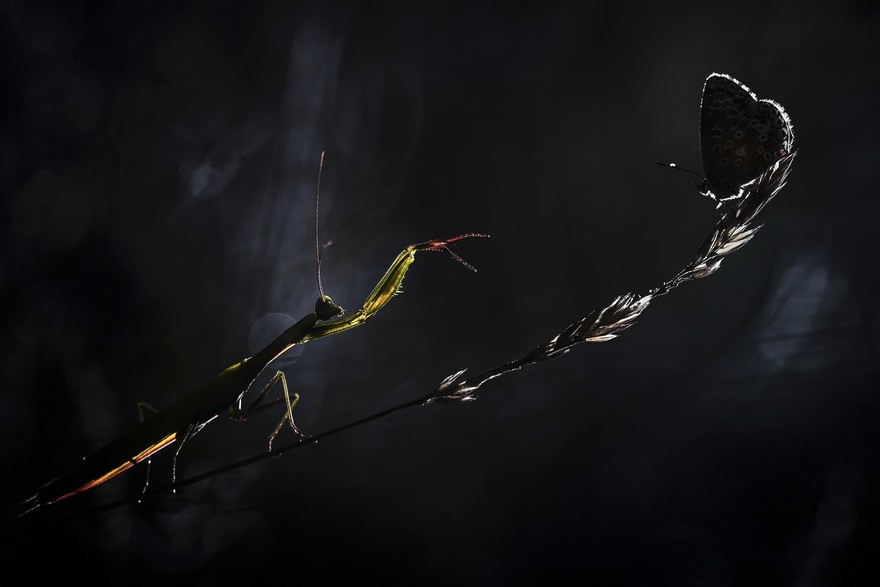I had spent all my summer taking pictures of this amazing and skillful predator in the Loire Department in France but I got the right picture only in September when the observation pictures of this kind of species is best.
The biotope was overflowing with these hunting praying mantis and their devastating hooked fangs. It was a non-cultivated meadow at the edge of a river in a Natura 2000 classified area (Protected zone for the preservation of ecosystem). The rays of the sun were reflecting in the grass of the early morning. I was as usual, kneeled, looking for a potential encounter with a praying mantis.
When I first met my subject, it was at the top of an herb staring at a butterfly Azuré (Polyommatus bellargus) ready to attack it. These moments of hunting behaviour are always interesting to photograph. I positioned myself towards the sun, to have a backlit image. In spite of the light filtering through the grass, the shooting zone was quite dark and I had to increase the ISO, so as to keep some structure in the background. I also needed a high speed to freeze the moment. I was working with a Canon EOS 5D MarkII reflex camera and a Canon EF 100mm L USM IS lens. I was only some twenty centimetres away from them and I could see the praying mantra moving slowly towards its prey.
I took several pictures so as to make sure to get the right one. The praying mantis suddenly launched an attack on the butterfly but was too far from its prey and missed it. No breakfast for the praying mantis. At this moment, a beautiful ray lit the scene and illuminated the structure of mantis fangs. The image, as well as the day had been a success. I have taken the right picture and the butterfly survived.
For ease of post-processing, I do a lot of preparation before the shooting. It is important to fix the speed/depth of field /white balance so as to predetermine the general atmosphere. In some cases it isn’t possible and one needs to take the picture when it is possible. In the post-processing I increased the contrast to make the fangs and the butterfly stand out. I choose a landscape format rather than the original portrait one, to make the image more dynamic. I also changed brightness and clarity.
The Nightmare image was highly commended in the Macro category of Memorial Maria Luisa competition in 2014. The pictures in this competition need to be very similar to the original RAW files. That’s why when I am shooting I do my best to respect the original image. Sometimes however I modify colour temperature, but it is rather an exception as l prefer to get the result I see before pressing the shutter.


